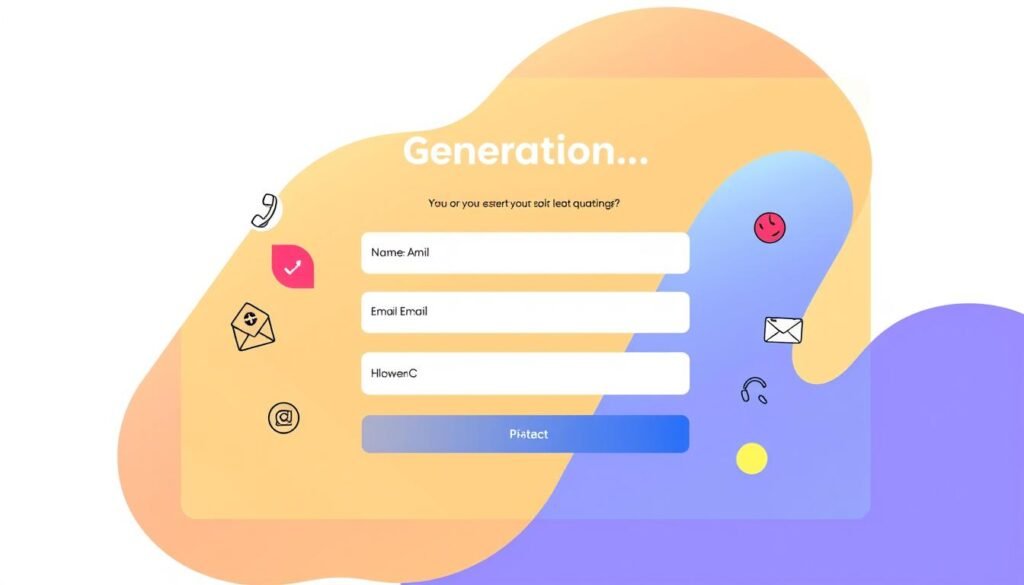Landing pages are crucial for grabbing potential customers’ attention and guiding them to your goals. Whether it’s getting leads, boosting sales, or promoting offers, knowing what makes a landing page great is vital.
This article explores the five main parts that make a landing page stand out. It helps businesses create pages that drive conversions. By focusing on these elements, you can improve your digital marketing and make the most of your landing pages.
Key Takeaways
- Understand the purpose and key differences between landing pages and websites
- Craft captivating headlines that immediately grab the visitor’s attention
- Develop compelling copy that speaks directly to your target audience
- Utilize visually appealing and relevant images to enhance the user experience
- Implement a clear and concise call-to-action to drive the desired conversion
What is a Landing Page?
A landing page is a single web page with a clear goal. It’s different from a website, which is a general online space for a business. Landing pages focus on one thing, like getting leads or selling a product.
Understanding the Purpose of Landing Pages
The main goal of a landing page is to turn visitors into leads or customers. These pages are made for a specific campaign or offer. They aim to guide visitors to take one action, like signing up or buying something.
Key Differences Between Landing Pages and Websites
Landing pages and websites have different roles online. Websites give a broad view of a company’s offerings. Landing pages are narrow and focused, aiming for a specific goal. Websites have many pages and options, while landing pages have just one action to take.
| Landing Page | Website |
|---|---|
| Focused on a single marketing goal or campaign | Broad overview of a company’s products, services, and brand |
| Streamlined design with a clear call-to-action | Multiple navigation options and pages |
| Designed to drive conversions | Serves as a hub for a company’s online presence |
“Landing pages are like laser-guided missiles for your marketing campaigns – they’re precise, targeted, and designed to hit your conversion goals with pinpoint accuracy.”
Captivating Headlines that Hook Visitors
The headline is key on a landing page. It grabs a visitor’s attention first. A good headline can keep someone interested or make them leave quickly. Making effective landing page headlines that meet your audience’s needs is crucial.
To make captivating headlines that hook visitors, follow these tips:
- Focus on the benefits – Show what your product or service offers. Use words that your audience likes.
- Keep it concise and clear – Your headline should be short and to the point. Avoid complicated words.
- Incorporate relevant keywords – Add the main keywords your audience looks for. This boosts your SEO.
- Create a sense of urgency – Use phrases like “Don’t miss out” to push for action now.
- Test and iterate – Try different headlines and use A/B testing to see what works best.
By using these headline best practices, you can make landing page headlines that grab attention. They should show your value and encourage people to explore more.
“Your headline is the first, and perhaps only, impression you make on a prospective reader.” – David Ogilvy
Compelling Copy that Speaks to Your Audience
When it comes to landing page copywriting, making persuasive content that speaks to your audience is key. Your landing page’s body copy should be short, focused on benefits, and meet your visitors’ needs.
Crafting Persuasive and Engaging Content
To make engaging landing page copy, focus on these important points:
- Clearly tell your audience how your product or service solves their problems.
- Use a friendly and relatable tone to connect with your visitors.
- Point out the unique benefits and features of your offering.
- Add social proof like customer testimonials to build trust.
- Create a strong call-to-action to get visitors to act, whether it’s signing up or making a purchase.
By writing persuasive and engaging content that meets your audience’s needs, you can show the value of your offering. This can lead to more conversions on your landing page.
“The difference between the almost right word and the right word is really a large matter – it’s the difference between the lightning bug and the lightning.” – Mark Twain
Remember, the secret to successful landing page copywriting is finding the right balance. You want to educate, inspire, and motivate your visitors to take action.
Landing Page Tips: Visuals that Captivate
In the digital marketing world, first impressions are key. Visuals on landing pages are crucial for grabbing attention and sharing your message. Using the right landing page visuals can make your page look better, strengthen your brand, and stick in visitors’ minds.
The Power of Relevant and High-Quality Images
Good images and visuals are vital for landing page success. They can do a lot, like:
- Grab the user’s attention and create a compelling first impression
- Illustrate your product or service in a clear and visually engaging way
- Reinforce your brand identity and create a cohesive visual experience
- Enhance the overall aesthetics of your landing page, making it more visually appealing
When picking visual elements for landing pages, choose images that fit your brand and message. Stay away from generic stock photos that don’t feel real or connected to what you offer.
“Visuals have the power to captivate, inform, and persuade. Leveraging the right landing page visuals can be a game-changer in driving conversions and creating a lasting impression on your audience.”
Take the time to find and use high-quality images that match your landing page’s content. This focus on visuals can greatly improve your page’s success.

Clear and Concise Call-to-Action
The call-to-action (CTA) is the cornerstone of a successful landing page. It guides visitors to the action you want them to take. This could be signing up for a newsletter, making a purchase, or downloading a resource. A clear, concise, and compelling CTA can greatly increase the chances of visitors taking action.
To craft an effective landing page call-to-action, follow these CTA best practices:
- Keep it short and simple: CTAs should be direct and to the point. Use verbs like “Download,” “Sign Up,” or “Get Started.”
- Use contrasting colors to make the CTA stand out: Choose a button color that contrasts with the rest of the page.
- Highlight the value proposition: Emphasize the benefits visitors will get by taking the action.
- Optimize for mobile: Make sure the CTA is easy to click on both desktop and mobile.
- Test and iterate: Keep trying different CTA variations to find the most effective CTAs for your audience.
By following these CTA best practices, you can create a landing page call-to-action that grabs visitors’ attention. It will encourage them to take the action you want, leading to more conversions and meeting your marketing goals.
“An effective call-to-action is the difference between a landing page that converts and one that doesn’t.” – Digital Marketing Expert
Effective Lead Capture Forms
Capturing leads is key on a landing page. Lead generation forms are vital. But, it’s important to balance collecting data with keeping users happy. A form that’s too complex or pushy can scare off visitors, hurting your lead capture.
Balancing Data Collection and User Experience
To make a great lead capture form, follow these tips:
- Keep it concise: Only ask for the most important info, like name, email, and phone. Don’t overwhelm visitors with too many fields.
- Prioritize user-friendly design: Make the form look good and easy to use. Use clear labels and space things out well.
- Leverage progressive profiling: Get more info in smaller steps. This makes the form easier to fill out and boosts your chances of getting leads.
- Optimize for mobile: Make sure your form works well on phones. A lot of people visit your site on mobile devices.
- Offer value in exchange: Give something valuable in return for the visitor’s info. This makes them more likely to fill out the form.
By finding the right balance, you can make landing page lead capture forms that work well. They turn visitors into leads, helping your lead generation and form optimization goals.

| Feature | Effective Implementation | Ineffective Implementation |
|---|---|---|
| Form Length | Concise with only essential fields | Lengthy with numerous unnecessary fields |
| User Experience | Intuitive layout, clear instructions, and mobile-responsive design | Poorly designed, confusing, and not optimized for mobile |
| Data Collection | Progressive profiling to gather information incrementally | Attempting to collect all data at once, overwhelming visitors |
| Incentive | Offering valuable content or resources in exchange for information | No perceived value for the visitor to provide their information |
Mobile Responsiveness and User Experience
Making sure your mobile-friendly landing pages work well on all devices is really important. A responsive design that changes easily on different screens can boost engagement and sales. It also makes customers happier.
To make your landing page better for mobile users, follow these tips:
- Start by designing for mobile screens first. This ensures your page works well on smaller devices.
- Use a layout that changes based on the device. This makes sure everything fits right, from text to buttons.
- Make your page load fast. Use smaller images, avoid big files, and use caching to speed things up.
- Keep your design simple. Make it easy for mobile users to move around and understand your content.
- Make sure your forms are easy to use on mobile. Use big buttons and simple steps to fill out forms.
By focusing on mobile responsiveness and user experience optimization, you can make landing pages that grab and keep mobile users’ attention. This can lead to more leads and help your business grow.
“A mobile-friendly landing page is no longer a nice-to-have, but a must-have in today’s digital landscape.”
| Metric | Desktop | Mobile |
|---|---|---|
| Bounce Rate | 35% | 20% |
| Average Time on Page | 2 minutes | 3 minutes |
| Conversion Rate | 8% | 12% |
A/B Testing for Continuous Improvement
Success with your landing page comes from always trying to get better. By doing A/B tests, you can see which parts of your page work best. This includes things like headlines, images, and calls-to-action (CTAs).
Using data to guide your decisions is crucial. A/B testing helps you understand what your audience likes. This way, you can make changes that boost your conversion rates. It keeps your page exciting and relevant to your customers.
Being dedicated to improving your landing page through A/B testing puts you ahead. It helps you make your marketing more effective. By always improving, you can make your page better for users and increase your sales.






